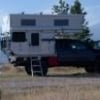Redarc actually recommends 4 or 6awg, depending on the length of the run. Their install manual goes from 2 to 6, depending on the run. There's a little chart in it.
And, same as you, only w/ redarc, it did not like the 10awg factory wiring. Redarc and Mule both suggested I upgrade it, which I did, and problem solved.
redarc does have a engine sense line, but it is not "required" unless you have a smart alternator.
I don't have a smart alternator, but maybe connecting that line would have solved the issues I was having w/ voltage drop.. Not sure.. I just ran heavier wire.
Did you just tie the engine sense line right into the positive feed line? I know my 2014 F-350 has a "computer controlled" alternator, but it seems that it is always putting out 13.75 volts and then if it senses it needs it can bump it up to 14.something.
Sounds like if the least it's going to put out is 13.75 then I don't need the engine sense line and the RedArc BCDC will just sense the increased voltage via positive input and power the unit on?


















